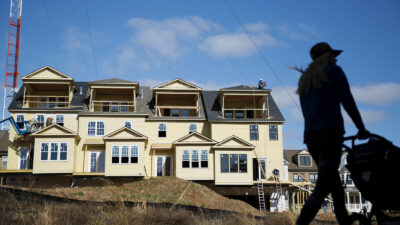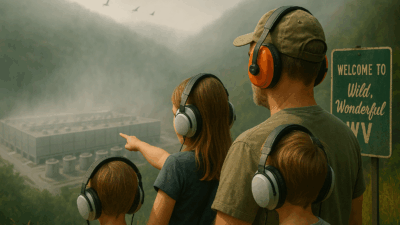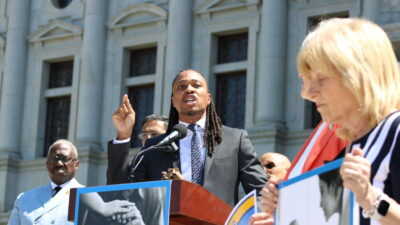ATLANTA — A once-downtrodden meatpacking district in Manhattan now commands some of the highest rents in New York City.

In Atlanta, an eastside community once peppered with public housing projects that some suburbanites avoided now hosts more spots to grab a $15 cheeseburger or a $20 cocktail.
And some river towns by Philadelphia that tumbled economically along with the coal industry are now brimming with breweries and outdoorsy attractions.
These and other landscape-altering metamorphoses can largely be credited to the urban renewal efforts sweeping the nation — for better or worse.
Redevelopment projects across the country have in many cases become synonymous with gentrification — and, in effect, with the displacement of residents. So as city leaders embark upon missions to create new from the old, so too are they challenged with a sort of cultural and financial calculus to determine how their work will reimagine the built environment — and who the fruits of their labor will be for.
With tact and compassion, experts say, these initiatives don’t have to threaten communities.
In the mid-to-late-2000s and early 2010s, New York City’s High Line project transformed an abandoned rail corridor in Chelsea into a 1.45-mile linear park, drawing unprecedented investor interest, sending nearby housing prices sky-high(er), and attracting high-end shops and restaurants. But Manhattan is Manhattan, and that evolution was more so accelerated by the revival of unused train tracks than inspired by it.
Rural, formerly industrial cities surrounding Pennsylvania’s Schuylkill River, on the other hand, were aching for a jumpstart. It came in the form of the Schuylkill River Trail project.
“They had a lot of the issues that abandoned towns have,” said Elaine Schaefer, the project’s executive director. “For the most part, they’re towns that were desperately looking for revitalization, and they’re looking for a new industry to support their people.”
Now, many of those areas are booming with brew pubs, kayaking outfitters, and other outdoor recreation offerings.
In the capital of the South, things are different. Following in the High Line’s urban design footsteps, Atlanta leaders are paving over a 22-mile loop of old railroad encasing the city’s urban core, linking dozens of neighborhoods and spurring striking growth. The project, called the Beltline, became a fierce economic engine even before crews poured the first concrete in the late 2000s, and it has since contributed to the exodus of longtime residents who couldn’t keep up with rising housing costs along the trail.
“No redevelopment project in the Atlanta region, and arguably in the country, has been more transformative than the Atlanta Beltline,” wrote Georgia State University urban studies professor Dan Immergluck wrote in his new book, “Red Hot City: Housing, Race, and Exclusion in the Twenty-First Century.
Now, as the Beltline snakes through communities on each rung of the socioeconomic ladder, city planners, developers, and investors across the country are taking notes — both on how to spur economic development and, ideally, how to mitigate its side effects.
When Ryan Gravel concocted the idea for the Beltline as his master’s degree thesis at Georgia Tech in 1999, he envisioned a network of trees, trails, and transit enveloped by new art, restaurants, retail, and residences — including plenty of affordable housing.
The project’s visionary, an urban designer by trade, knows things didn’t go according to plan.
An equitable development plan published by Beltline leaders in 2012 — a roadmap for keeping the project inclusive — fell by the wayside thanks in part to financial constraints stemming from the Great Recession.
Gravel resigned from the trail’s board of directors in 2016, questioning the team’s commitment to providing affordable housing around the loop.
Strained by the economic downturn and a disproportionate focus on building the trail before making sure it was done right, the Beltline project, lacking binding safeguards to prevent mass displacement, chugged along without enough concern for the citizenry it would directly impact, Gravel said.
“Without the policy framework in place, projects like the Beltline and the High Line just become conduits for the monetization of that urban culture,” he said. “Anything you do to improve communities makes them more desirable and, therefore, prices go up. Without any policy to protect people in the face of that change, we get these negative outcomes.”
Right now, Gravel said, the gold standard for equitable urban renewal practices is Washington, D.C.’s 11th Street Bridge Park project — a nascent plan inspired somewhat by the Beltline’s initial equitable development guidelines that’s now teaching Atlanta project leaders a thing or two about keeping community engagement and preservation top of mind.
In D.C., project leaders want to build a linear park across the Anacostia River, which separates wealthy, predominantly white communities to the west from the lower-income, mostly Black neighborhoods to the east.
“There is a $390,000 delta between median home values on one side of the river and the other, separated by 900 feet of water, which is crazy,” said Scott Kratz, the head of the 11th Street Bridge Park project.
Kratz said the project, to be built atop long-neglected piers, could break ground at the end of the year and open in 2026, but it’s been years in the making, with much of that time spent attempting to ensure the finished product isn’t just another displacement machine.
To date, project leaders have invested $86 million “to implement equitable development strategies” — based in part on the plan the Beltline initially sought to carry out — “and that is not including construction costs,” he said.
Building community trust is key, Kratz said. Maintaining it is just as important.
“Oftentimes these projects are being planned, designed, and constructed in neighborhoods that have a huge and justifiable trust deficit,” he said, “because people came in and made all these promises [elsewhere]. And for a variety of reasons, those promises haven’t been fulfilled.”
Kratz’s team started with community engagement, then bought property and created a community land trust — a model wherein a nonprofit guarantees long-term housing affordability by controlling land on behalf of residents, shielding them from market forces — propped up robust workforce development programs and small business assistance initiatives, and invested in arts and culture. And it doesn’t hurt that D.C. Mayor Muriel Bowser last year dedicated $500 million of the municipal budget to affordable housing initiatives, Kratz said.
As Gravel said, the onus isn’t entirely on project leaders to ensure inclusivity near their development site; political and community leaders bear some of the burden, too.
Atlanta has lately shied away from progressive planning reforms, like zoning for increased density, that could boost the city’s affordable housing stock, and Georgia lawmakers are loathe to repeal the state’s decades-old ban on rent control. (D.C. has both of those assets, among others.)
“These projects should be vehicles to deliver on all those bigger goals” for community benefits. “Mostly, they are not set up that way,” said Liz Thorstensen, the vice president of trail development for the national Rails-to-Trails Conservancy.
Developing guardrails like legally binding community benefits agreements, she said, “require more work for those on the planning side, but the benefits for the community are immeasurable.”
Essentially, a rising tide lifts all ships.
To the Beltline’s credit, its chief executive Clyde Higgs, who took the project’s top job in 2019, has been working to put its inclusion and housing goals back on track, Kratz and Gravel both noted.
“The Atlanta Beltline has experienced success greater than anyone imagined,” Higgs said, lamenting the economic forces that challenged its housing affordability goals in the project’s early days.
In recent years, though, the Beltline has purchased land for housing, and the city enacted inclusionary zoning policies that require new residential developments near the trail to set aside some units for affordable housing. That instrument hasn’t done enough to counterbalance fast-rising housing costs, but it’s at least making progress.
To date the Atlanta Beltline is 56 percent of the way toward achieving our goal of creating or preserving 5,600 affordable housing units by the end of 2030, Higgs said, and they’ve bought 65 acres of land for redevelopment.
Another lesson the project head said he’s learned: “Put community first.”
“Any city seeking to undertake this kind of effort must have a robust engagement plan and the team to execute it,” he said.







